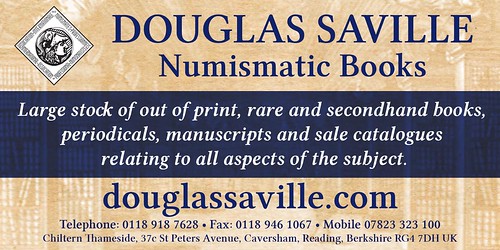
PREV ARTICLE
NEXT ARTICLE
FULL ISSUE
PREV FULL ISSUE
READER THOUGHTS ON CONTINENTAL DOLLAR ORIGINSDavid Fanning The ongoing discussion of the Continental Currency “dollars” has been fascinating, and Rob Rodriguez is to be congratulated for locating addition contemporary source material. A couple people have been kind enough to cite my refutation of Catherine Eagleton’s Numismatic Chronicle article, and I wanted to point out that the final version of that short article was published in the Colonial Newsletter (“A Few Notes on Catherine Eagleton’s Numismatic Chronicle Article on the Continental Dollar,” CNL, August 2015, pp. 4285-86). The version published in The E-Sylum is pretty similar, though. The item discovered and reported by Eagleton is pretty neat and could have been the basis of a good article; as it is, however, she drew far too many conclusions from far too meager evidence and introduced a couple of serious factual errors in her article that undermined her claims. Bob Leonard offers another perspective. -Editor
The two newspaper stories cited by Rob Rodriguez have been known for over 25 years. Philip L. Mossman, in Money of the American Colonies and Confederation [ANS, 1992], pp. 150-51, quoting AJN, Oct. 1891, p. 45, reprinted similar ones. He concluded, “These two newspaper bulletins provide no assistance in unraveling the mystery of the illusive Continental copper coin or the actual Continental Currency...” (p. 151). I concur; no such coins are known, and they do not describe Continental Dollars. Questioning the authenticity of the ad pasted in the 1815 era catalog of the Sarah Sophia Banks collection is unjustified; this book has been in the British Museum for nearly 200 years. No duplicate has been located (I have tried) because it is not a newspaper ad, but a handbill with no printing on the verso. The key timeline for the Continental Dollar is: 1783 (Sept. 3) - The Treaty of Paris ends the Revolutionary War, recognizing American Independence. 1783 (Late in year) - First illustration of a Continental Dollar (with German legends) appears in Leipzig. 1783? - Medal commemorating the Treaty of Paris issued, same size and metal as Continental Dollar, with similar reverse. 1783 or 1784 - Pierre Eugene Du Simitiere notes, "a Coin the size of a Crown with devices and mottos taken from the continental paper money, Struckt in London on Type-Metal, and dated 1776." Du Simitiere, the leading American numismatist of his day, lived in Philadelphia continuously from 1774 to 1784 and knew John Adams and John Jay; he was certainly in the best position to know whether Continental Dollars were struck in America or not. 1784 (Oct.) - Pierre Eugene Du Simitiere dies without publishing his knowledge of the origin of the Continental Dollar. Circa 1785 - Richard Watson, Bishop of London, is shown a Continental Dollar; he describes it in Chemical Essays, Vol. IV, 1786. 1789 (Jan. 1) - The Independent Chronicle and the Universal Advertiser, in response to Chemical Essays, denies that there ever was such a coin as the Continental Dollar. 1789 or before - avid coin collector Sarah Sophia Banks of London acquires a Continental Dollar, Newman 3-D. 1789 (-91?) - Jonas Carlsson Dryander, librarian to Sir Joseph Banks, President of the Royal Society, notes in the first catalog of the Banks collection, "Congress Dollar. 1776, never current, struck on speculation in Europe, for sale in America." Unfortunately, this remark is not published until 2015. 1790 (Feb. 21) – Paul Revere wrote to Bishop Watson, "as for pewter money struck in America, I never saw any, and I have made carefull (sic) inquiry." Circa 1815 - Sarah Sophia Banks completes a second catalog of her collection. Dryander's note is copied verbatim, and below it a handbill is pasted in offering "American MEDALS at Six-Pence Each," describing Continental Dollar Newman 3-D. To make any money at a price of sixpence, the seller must have had hundreds, maybe a thousand, on hand--about equal to all the survivors of Phase Two known. My Conclusion: Continental Dollars were first illustrated in Europe (1783) and first described in London (1786). Pierre Eugène Du Simitière (1783/84) wrote that they were struck in London, and Jonas Carlsson Dryander (circa 1789) noted that they were struck in Europe. They are not mentioned in the journals of the Continental Congress, and the editor of Independent Chronicle and the Universal Advertiser (1789) wrote that they did not even exist, while Paul Revere, after careful inquiry, wrote that they were not to be seen in America (1790). Some Continental Dollars have ornamental edges, a technology known in Europe but unavailable in America in 1776. Continental Dollars must have been made in Europe late in 1783, after the signing of the Treaty of Paris, though perhaps some were restruck later. Clearly the community is of two minds on this issue. As noted from the outset hard evidence is scant, but hopefully more clues will surface in time. -Editor
To read the earlier E-Sylum article, see:  Wayne Homren, Editor The Numismatic Bibliomania Society is a non-profit organization promoting numismatic literature. See our web site at coinbooks.org. To submit items for publication in The E-Sylum, write to the Editor at this address: whomren@gmail.com To subscribe go to: https://my.binhost.com/lists/listinfo/esylum All Rights Reserved. NBS Home Page Contact the NBS webmaster 
|